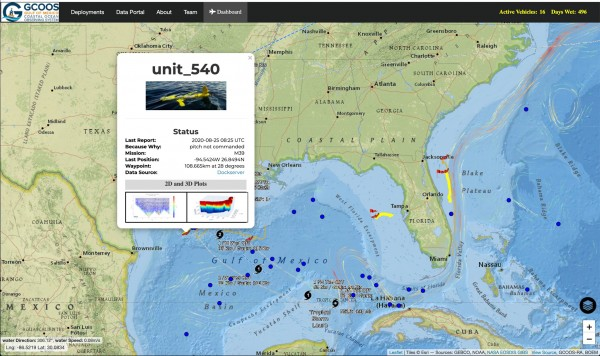Aug 27 2020
The prediction of hurricanes largely involves data and the ability to access accurate information easily and quickly.
 The image above shows the location of glider 540 on the GCOOS glider map. 540 is near the projected path of Hurricane Laura. Image Credit: GCOOS.
The image above shows the location of glider 540 on the GCOOS glider map. 540 is near the projected path of Hurricane Laura. Image Credit: GCOOS.
For the third consecutive year, the Gulf of Mexico Coastal Ocean Observing System (GCOOS) has collaborated with research groups from Florida, Mississippi, and Texas to monitor and share data from a “glider picket line” in the Gulf.
The picket line includes an array of unmanned underwater robots, also called gliders, launched in the Atlantic, Gulf, Caribbean, and Sea. The robots have been programmed to gather information related to ocean parameters from regions where tropical storms and hurricanes usually form or strengthen.
The robots map ocean heat content by gathering data from across the water column—from the sea surface to its depths. Ocean heat content is a crucial factor required to estimate the intensity of a storm. The gliders improve the information provided by satellites, which can only collect the temperature of the surface of the ocean.
The gliders then send their data to GCOOS via satellite in near-real-time. At GCOOS, the data is automatically processed and output in the form of maps that indicate the locations of the gliders and includes 3D profiles of temperature and other parameters, like salinity. Then, the data can be fed into hurricane models by meteorologists to produce forecasts indicating where storms could possibly move and how intense they might turn.
Marco has already scattered into a tropical depression and Laura is predicted to strengthen into a dangerous hurricane before it makes landfall late Wednesday or early Thursday, it is highly crucial to track ocean heat content.
Having two named storms in the Gulf of Mexico at the same time is extremely unusual—we’ve only recorded that twice before, in 1933 and 1959. The additional information that we’re gaining from the picket line, combined with GCOOS’ innovative tools can help add valuable data to improve forecasting and give the public as much advance notice of storms as possible so they can make appropriate decisions for their safety.
Brian LaMarre, NOAA
LaMarre is the regional collaboration team lead for the Gulf of Mexico and meteorologist-in-charge of the National Weather Service Tampa Bay office.
The aim of GCOOS is to offer reliable, accurate, and timely information on the open ocean and coastal ocean waters of the Gulf of Mexico to ascertain a clean, healthy, and productive ocean, as well as a resilient coastal zone.
GCOOS collaborates with governmental and non-governmental organizations, research laboratories, universities, and emergency managers across the Gulf of Mexico to gather and share data.
In this case, GCOOS is monitoring gliders operated by the U.S. Navy, the University of South Florida, the University of Southern Mississippi, Texas A&M University’s Geochemical and Environmental Research Group, and NOAA’s Atlantic Oceanographic and Meteorological Laboratory.
As we move into the busiest part of our annual hurricane season in the Gulf, it’s important that forecasters have access to the most accurate, timely data possible and it’s great to see public-private partnerships making this happen.
Dr Barbara Kirkpatrick, Executive Director, GCOOS
Dr Kirkpatrick added, “Currently, there are three gliders in the picket line that are very near Laura’s track that are providing important information that we need to protect lives and property in the Gulf. Residents should stay alert and stay safe.”
Source: https://gcoos.org/